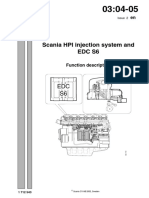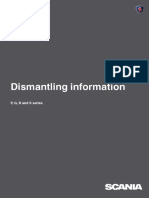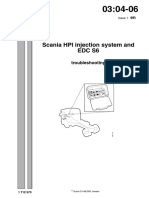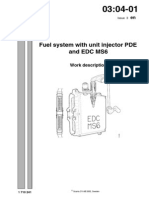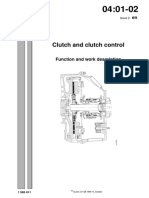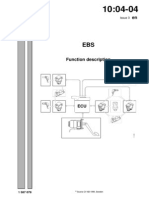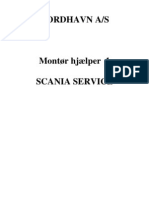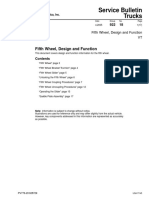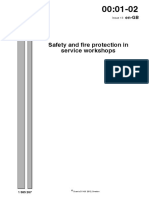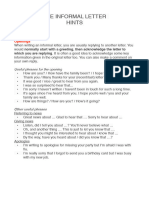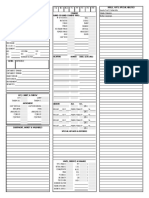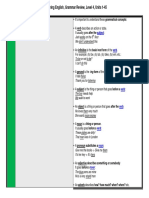Sistema Combustible Xpi
Sistema Combustible Xpi
Uploaded by
Robert Orosco B.Copyright:
Available Formats
Sistema Combustible Xpi
Sistema Combustible Xpi
Uploaded by
Robert Orosco B.Copyright
Available Formats
Share this document
Did you find this document useful?
Is this content inappropriate?
Copyright:
Available Formats
Sistema Combustible Xpi
Sistema Combustible Xpi
Uploaded by
Robert Orosco B.Copyright:
Available Formats
03:14-01
Issue 5
XPI fuel system
Troubleshooting
Scania CV AB 2012, Sweden
en-GB
Contents
Contents
XPI fuel system
Background............................................................... 3
Using the troubleshooting guide............................... 3
Troubleshooting
S-a Basic check......................................................... 4
S-b Start-up check .................................................... 5
L-a Low pressure check............................................ 6
H-a High pressure check when the engine starts...... 7
H-b High pressure check when the engine does
not start ..................................................................... 8
Descriptions, Low pressure check
L1 Low pressure check.......................................... 9
L2 Checking the suction filter ............................... 9
L3 Checking the feed pump .................................. 9
L4 Checking the feed pump drive ......................... 9
L5 Checking the high pressure pump drive......... 10
L6 Checking the supply pressure at the test
connection on the high pressure pump ................... 10
Descriptions, High pressure check
H1 Checking for internal leaks............................ 11
H2 Checking the return fuel pressure.................. 11
H3 Checking the safety valve.............................. 12
H5 Verification of a faulty injector ..................... 14
H6 Checking for internal leaks............................ 14
H7 Checking the return fuel pressure.................. 16
H8 Checking the safety valve.............................. 17
H9 Checking the high pressure pump ................. 17
Scania CV AB 2012, Sweden
03:14-01
XPI fuel system
XPI fuel system
Background
It has been difficult to troubleshoot the XPI
fuel system with the current troubleshooting
guide, Workshop Manual 03:14-01 issue 3.
The troubleshooting trees are clearer in this
issue of the presentation. Both the
troubleshooting trees and instructions have
been revised so that it is easier to troubleshoot
the XPI system.
IMPORTANT!
The fuel system is very sensitive to dirt. It is
therefore very important that everything is as
clean as possible when work is carried out on
the fuel system.
Using the troubleshooting
guide
Start troubleshooting by looking at
troubleshooting tree S-a. This troubleshooting
tree helps you to choose where to start
troubleshooting.
The troubleshooting trees are read from the top
down. The boxes contain instructions you can
follow. These instructions sometimes refer to
other more detailed instructions further on in
the document. After having carried out the
instructions, you should continue to the next
set of instructions indicated by the arrows.
03:14-01
Scania CV AB 2012, Sweden
Troubleshooting
Troubleshooting
S-a Basic check
Before and after troubleshooting the XPI fuel system, check the following:
Check any fault codes using SDP3.
There are no active
fault codes
There are active fault
codes
Troubleshoot according to the troubleshooting
text.
Can the engine be started?
Yes
No
There may be a fault in the fuel system. If
there is no other XPI-related fault, the cause
may be outside the fuel system. Start
troubleshooting the fuel system from S-b.
The engine starts but there are inactive fault
codes or other indications of faults in the fuel
system.
No
Yes
There may be a fault in the fuel system. Run
the engine until warm and check that no new
fault codes have been generated. If not, start by
troubleshooting from L-c.
The cause of the problem is not the fuel
system. Finish troubleshooting and continue
looking for other causes of the fault.
Scania CV AB 2012, Sweden
03:14-01
Troubleshooting
S-b Start-up check
S-b Check that there is fuel in the tank and that
it does not contain water.
There is fuel in
the tank and no
water
There is no fuel in the
tank but there is water
in the tank
The cause may be no fuel or water in the
tank. Rectify the problem and continue from
S-a.
Pump with the hand pump until resistance
builds up. Check for external fuel leaks at the
feed pump, filter housing and fuel pipes. Open
the ventilating valve to release the pressure.
There is no
external leakage
or it is not
possible to build
up the pressure
There is external
leakage
The cause may be external leakage. Rectify
the leakage and continue from S-a.
The problem may be present in the low
pressure section or in the high pressure
section. Start by troubleshooting the low
pressure section from L-a.
03:14-01
Scania CV AB 2012, Sweden
Troubleshooting
L-a Low pressure check
L-a Check the feed pump as described in
L1.
No fuel comes
out during both
checks
The problem may be between
the fuel tank and the feed
pump. Renew the fuel filter as
described in L2. Repair all the
faults that are detected and
continue from S-a.
... with the hand pump but not
with the starter motor
Fuel comes
out ...
... during both
checks
... with the starter
motor but not with the
hand pump.
Check the feed pump as
described in L3.
L-c Measure the feed pump as described
in L6.
No fuel
comes out
The
pressure
is too low
A little fuel
comes out
The feed pump
drive is not
working
The pressure is normal
The problem may be on the high
pressure side. If the engine can be
started, continue from H-a.
Otherwise continued from H-b.
Check the feed pump drive as
described in L4.
The feed
pump is
defective
The cause may be the feed pump
drive. Also check the high
pressure pump drive as described
in L5. Then continue from S-a.
Renew both fuel filters. Bleed the fuel
system and measure the feed pressure as
described in L6 again.
The
pressure
is still
too low
The cause may be the feed pump. Renew the pump, bleed
the fuel system and continue from S-a.
The hand pump may be
faulty. Renew the hand
pump and resume
troubleshooting from L-a.
Scania CV AB 2012, Sweden
The pressure is
normal
The cause may be blocked fuel
filters. Rectify the cause of the
blockage, bleed the system and
continue from S-a.
03:14-01
Troubleshooting
H-a High pressure check when the engine starts
The cause may be
the safety valve.
Renew the valve
and continue from
S-a.
The safety
valve is
defective
H-a The engine starts. Check the
safety valve as described in H3.
The safety valve is working
The safety valve opens
when idling
Check for internal leaks as described
in H1.
The pressure is
normal
... cylinder is not identified
Check the return fuel
pressure as described in H2.
The pressure
is normal
... cylinder is
identified
Verify the faulty injector and plug as
described in H5.
The pressure
is too high
The fault
cannot be
verified
Check the fuel inlet metering
valve using SDP3.
The fuel inlet
metering
valve is
defective
The pressure is falling
and ...
Check for internal leaks as
described in H6.
The fuel inlet
metering valve is
working
The fault
cannot be
verified
The cause may be the fuel inlet metering
valve. Renew the valve and continue from
S-a.
The problem may be in the high pressure pump. Check
the high pressure pump as described in H9 and repair all
faults that are detected. Continue from S-a.
03:14-01
Fault
verified
Scania CV AB 2012, Sweden
Fault
verified
... there is
external
leakage
The cause may
be external
leakage.
Rectify the leak
and continue
from S-a.
The cause may be the
injector. Renew the
injector and continue
from S-a.
The cause may be the high
pressure connections. Detach and
visually inspect all high pressure
connections and torque tighten
them. Continue from S-a.
Troubleshooting
H-b High pressure check when the engine does not start
H-b The engine does not start. Check the
fuel pressure in the accumulator (T111)
with SDP3 and run the starter motor.
Cannot build up
or maintain
pressure
Can build up and
maintain pressure
The cause is probably not the fuel
injection system. Continue searching
for other causes.
Check the return fuel pressure as
described in H7.
The return fuel
pressure is normal
or low
The return fuel pressure
is too high
The cause may be the high pressure
connections. Detach and visually
inspect all high pressure connections
and torque tighten them. Continue from
S-a.
Check the safety valve as described in H8.
The safety valve is
working
The safety valve is
defective
The cause may be the safety valve.
Renew the valve and continue from
S-a.
The problem may be in the high pressure
pump or the fuel inlet metering valve.
Carry out check H9 and repair all faults
that are detected. Continue from S-a.
Scania CV AB 2012, Sweden
03:14-01
Descriptions, Low pressure check
Descriptions, Low pressure check
L1 Low pressure check
1 Open the test connection on the high
pressure pump.
2 Pump using the hand pump. Check that
fuel comes out of the test connection.
L3 Checking the feed
pump
1 Detach the pipe for outlet fuel from the
feed pump. Place a container under the free
end of the pipe.
4 Close the test connection.
2 Turn the engine over using the starter
motor for about 20 seconds. The feed
pump provides about 1.2 l/min. The
correct quantity for 20 seconds is
0.3-0.4 litres.
L2 Checking the suction
filter
L4 Checking the feed
pump drive
3 Turn the engine over using the starter
motor. Check that fuel comes out of the
test connection.
Note: When renewing the suction filter, check
the following with the suction filter removed.
1 Pump with the hand pump and check that
fuel free from air flows out of the hole on
the inside of the filter housing.
2 If no fuel comes out, check the suction
strainer and all joints on the suction pipe
up to the fuel tank armature. Renew the
seals and check-tighten the connections.
1 Remove the feed pump from the highpressure pump bracket.
2 Turn the feed pump by hand. The pump
should rotate freely and the drive shaft in
the pump should be intact.
3 Check that the drive pins in the high
pressure pump are intact.
4 Turn the engine over using the starter
motor. Check that the feed pump drive in
the high pressure pump rotates.
3 If fuel comes out, fit a new filter and bleed
the fuel system.
03:14-01
Scania CV AB 2012, Sweden
Descriptions, Low pressure check
L5 Checking the high
pressure pump drive
1 Remove the high pressure pump.
2 Turn the engine over using the starter
motor. Check that the high pressure pump
drive rotates in the timing gear.
3 Renew the pump drive gear if it does not
rotate or is damaged. Check for resulting
damage to the high pressure pump gear.
Damaged gears should be renewed.
4 If the pump drive gear in the timing gear
rotates and is not damaged:
Check that the high pressure pump gear is
properly seated on the shaft. If the gear is
loose, the shaft may be damaged. Do not
tighten the gear. Renew the high pressure
pump.
If the gear is jammed, the high pressure
pump is defective. Renew the high
pressure pump.
L6 Checking the supply
pressure at the test
connection on the high
pressure pump
1 Connect pressure gauge 99 362 to the test
connection on the high pressure pump and
open the test connection.
2 Turn the engine over using the starter
motor. Read the pressure after
approximately 20 seconds. The pressure
should be more than 2 bar.
Note: Low feed pump pressure may be caused
by a defective feed pump, or may be a
symptom of a high pressure pump with a
defective cylinder head.
Note: Make sure that the battery level is high
enough to run the engine at 90 rpm with the
starter motor.
3 If the engine starts, increase engine speed
to 1,500 rpm. Read the pressure. The
pressure should be between 9 and 14 bar.
Note: Remember that there is currently no
method for confirming whether a fuel filter is
blocked. If the complaint is that fault code 135
is activated when under heavy load it is
probable that the fuel filter is blocked. The high
pressure pump can still create a pressure of
between 9 and 14 bar even with a blocked
filter.
4 Close the test connection and remove the
pressure gauge.
10
Scania CV AB 2012, Sweden
03:14-01
Descriptions, High pressure check
Descriptions, High pressure check
H1 Checking for internal
leaks
H2 Checking the return
fuel pressure
Note: Always use the latest version of SDP3 if
possible.
1 Connect pressure gauge 99 362 to the test
connection on the return fuel manifold and
open the test connection.
For SDP3 version 2.8 onwards:
2 Start the engine. Read the pressure with the
engine idling. The pressure should be
below 0.8 bar. If the pressure exceeds
0.8 bar the overflow valve on the return
fuel manifold should be cleaned and
visually inspected. Start again from step 1.
1 Follow the instructions for Fuel leak test in
SDP3.
For SDP3 version 2.7:
1 Start the engine.
2 Start the test Checking for internal leaks in
SDP3.
3 Switch off the engine. Read the pressure
remaining in the accumulator using SDP3.
There should be some pressure remaining.
If the pressure falls more than 300 bar
within one (1) minute, there are internal
leaks.
4 Check cylinder balancing at idling speed
using SDP3. Note if any cylinder deviates.
Note: When the overflow valve is removed air
will be introduced, opposite the flow direction.
It takes time for the system to bleed itself.
During this time the measurement is not
reliable. Leave the engine idling for a while
before repeating the test. If the pressure still
exceeds 0.8 bar, there is internal leakage in an
injector.
3 Switch off the engine, remove the pressure
gauge and close the test connection.
5 Perform a cylinder output test using SDP3.
Note which cylinder deviates from the
others by having a higher output.
6 By comparing the two results with each
other, a cylinder with deviations in both
tests can be identified.
Note: Remember that several injectors can
sometimes be faulty at the same time.
03:14-01
Scania CV AB 2012, Sweden
11
Descriptions, High pressure check
H3 Checking the safety
valve
1 Start and run the engine at idling speed for
15 seconds and then switch off 15 voltage.
Check whether the return pipe from the
safety valve to the return fuel manifold is
hot.
WARNING!
The accumulator may be under high pressure.
Reduce the pressure using SDP3 before starting
work. Wear protective goggles. There is a risk
of burn injuries when the safety valve is open.
2 If the return pipe is hot, this is because the
safety valve was open when the engine
was last run. The most probable cause of
this is that the fuel inlet metering valve is
stuck in the open position. Continue
troubleshooting by renewing the fuel inlet
metering valve.
3 If the return pipe is not hot, start the engine
and run the check Leak testing the safety
valve using SDP3 without removing the
return pipe.
WARNING!
For safety reasons it is important that the return
pipe is not removed during step 3. If the safety
valve opens during the check with the pipe
removed, hot fuel would spray out with great
force.
4 If the return pipe becomes hot during the
check Leak testing the safety valve the
safety valve is faulty. Continue
troubleshooting by renewing it.
5 If the return pipe does not become hot and
the accumulator pressure does not reach
2,400 bar, the safety valve is probably
working. Cancel the check and continue
troubleshooting the fuel system.
12
Scania CV AB 2012, Sweden
03:14-01
Descriptions, High pressure check
6 If the return pipe does not become hot but
the accumulator pressure reaches
2,400 bar, remove the return pipe, plug the
fuel manifold (9-13L) or the high pressure
pump (16L). Fit a plastic hose routed with
a fall down into a dry vessel so that small
amounts of fuel can be discovered.
Note: Assemble the plastic hose using parts in
the part list below.
Run the check Leak testing the safety valve
in SDP3 again and run it for approximately
5 min to allow any fuel drops to drip into
the vessel. Cancel the test if there are any
signs of fuel in the vessel. If the safety
valve leaks more than 3 drops a minute it is
faulty and must be renewed.
WARNING!
If the safety valve opens during the check,
large amounts of hot fuel would spray out.
Never run the test without monitoring.
7 Refit the engine pipe. Torque tighten.
Parts
Applies to 9, 13 and 16 litre engines.
Designation
Plastic hose
Union nut
Ferrule
Insert sleeve
Plug
Straight uniona
Sealing washera
Part No.
813 869
814 555
813 223
812 913
813 878
813 198
1 373 793
Quantity
1
2
1
1
1
1
1
a. Only applies to 16 litre engines.
03:14-01
Scania CV AB 2012, Sweden
13
Descriptions, High pressure check
H5 Verification of a
faulty injector
H6 Checking for internal
leaks
1 Remove the high pressure pipe to the
injector which has been identified in H1.
2 Plug the outlet of the identified injector at
the outlet port on the fuel accumulator
using tool 99 019. If the outlet port of
cylinder 1 has to be plugged, see the
instructions in TI 03-08 01 28.
3 Start the engine and repeat H1. This
system must be able to maintain pressure.
Note: Remember that several injectors can
sometimes be faulty at the same time.
Therefore if a faulty injector cannot be
verified, plug it and repeat step H1. If a second
faulty injector cannot be verified, continue
troubleshooting as described in H6.
WARNING!
Wear protective goggles. There is a risk of fuel
splashing from the high pressure connections
when pressurised.
The accumulator may be under high pressure.
Reduce the pressure using SDP3 before
starting work.
A tool must be made to determine whether the
fuel system is leaking. A pressure regulator, a
shut-off valve, 2 hose couplings, hose clamps,
hose and Tema quick release coupling 1100N
for connection to the test connection are
needed. Assemble the parts as illustrated on the
next page. It is vital that all couplings and
connections are tight.
1 Detach and remove all high pressure pipes
between the accumulator and the high
pressure connections.
14
Scania CV AB 2012, Sweden
03:14-01
Descriptions, High pressure check
2 Connect the tool to the test connection on
the return fuel manifold and open the test
connection.
IMPORTANT!
Open the fuel filler flap so that the pressure
does not deform the tank.
3 Pressurise the return fuel manifold. Slowly
increase the pressure. Listen for a bubbling
noise in the tank. The bubbling noise
indicates at what pressure the overflow
valve opens. The pressure should be higher
than 0.5 bar. Then pressurise the manifold
to max. 3 bar.
5 Renew the injector or injectors with
internal leakage as described above. When
renewing an injector, the tuning code of
the new injector must be programmed to
the correct cylinder using SDP3 and Basic
setting of adaptation of the injectors must
be performed.
IMPORTANT!
After renewing an injector with internal
leakage, the engine oil must be changed and
the oil filter renewed. If there is internal
leakage, soot quickly builds up in the engine
oil.
4 Listen for return leakage in the injectors by
blocking one high pressure connection at a
time and quickly removing the obstacle. If
there is internal leakage in the injector, a
hissing sound will be heard.
Tool for test pressurising the fuel system
A Shut-off valve
B - Pressure regulator
C Hose for connection to the fuel system
03:14-01
Scania CV AB 2012, Sweden
15
Descriptions, High pressure check
H7 Checking the return
fuel pressure
1 Connect pressure gauge 99 362 to the test
connection on the return fuel manifold and
open the test connection.
2 Crank the engine using the starter motor.
Read the pressure after approximately
20 seconds. The pressure should be below
0.8 bar.
3 If there is no detectable value after
20 seconds, let the starter motor cool and
repeat step 2.
Note: If there is air in the filter housing,
pressure cannot build up. Bleed the filter
housing and try again.
4 Remove the pressure gauge and close the
test connection.
16
Scania CV AB 2012, Sweden
03:14-01
Descriptions, High pressure check
H8 Checking the safety
valve
1 Remove the return pipe, plug the fuel
manifold (9-13L) or the high pressure
pump (16L). Fit a plastic hose routed with
a fall down into a dry vessel so that small
amounts of fuel can be discovered.
Note: Assemble the plastic hose using parts in
the part list below.
2 Crank the engine using the starter motor. If
fuel leaks out of the safety valve, it is
faulty and must be renewed.
3 Refit the engine pipe. Torque tighten.
Parts
Applies to 9, 13 and 16 litre engines.
Designation
Plastic hose
Union nut
Ferrule
Insert sleeve
Plug
Straight uniona
Sealing washera
Part No.
813 869
814 555
813 223
812 913
813 878
813 198
1 373 793
Quantity
1
2
1
1
1
1
1
2 If the cylinder head is not faulty and there
are still problems, it may be due to a faulty
fuel inlet metering valve. Try fitting a new
fuel inlet metering valve.
3 If the problem remains, the problem may
be present in the high pressure pump.
Renew the high pressure pump and
continue to S-a.
a. Only applies to 16 litre engines.
H9 Checking the high
pressure pump
1 Check the cylinder head on the high
pressure pump as described in the
workshop manual, see section 03-00 Fuel
system Scania XPI. If a fault is detected,
renew the cylinder head.
03:14-01
Scania CV AB 2012, Sweden
17
You might also like
- Scania Retarder 3Document33 pagesScania Retarder 3neilevcvr89% (37)
- SCR Fault Code Management: Issue 1Document18 pagesSCR Fault Code Management: Issue 1Ian100% (4)
- Scania DC13 XPI Inspection Manual - ENDocument44 pagesScania DC13 XPI Inspection Manual - ENمحمد حسن80% (5)
- Scania HPI System EDCDocument29 pagesScania HPI System EDCnoran100% (4)
- Fuel System T4FDocument50 pagesFuel System T4FDragan100% (2)
- DC16 Cylinder SequenceDocument1 pageDC16 Cylinder Sequencejengandxb100% (1)
- Hpi Work DescriptionDocument32 pagesHpi Work DescriptionHari100% (8)
- XPI Fuel System: en-GBDocument26 pagesXPI Fuel System: en-GBclaudio100% (2)
- XPI FUEL CIRCUIT Overview 9 and 13 Litre EnginesDocument3 pagesXPI FUEL CIRCUIT Overview 9 and 13 Litre EnginesNoeRtjahya Ahmad92% (12)
- Xpi Fuel Circuit: Fuel Manifold Self-DrainingDocument1 pageXpi Fuel Circuit: Fuel Manifold Self-DrainingAbdelkader GouddiNo ratings yet
- Scania Retarder TID - 0000788 - 01Document2 pagesScania Retarder TID - 0000788 - 01fugega100% (2)
- Sistema Combustible Xpi PDFDocument17 pagesSistema Combustible Xpi PDFwilmar_tovar_1100% (2)
- Hpi Function DescriptionDocument64 pagesHpi Function DescriptionHari71% (7)
- Wabco ABS/TC "D" 4 and 6 Channel System: Issue 3Document34 pagesWabco ABS/TC "D" 4 and 6 Channel System: Issue 3user100% (11)
- Scania P, G, R and S Series Workshop Manual - Dismantling Information PDFDocument106 pagesScania P, G, R and S Series Workshop Manual - Dismantling Information PDFLuciana Silveira100% (6)
- WSM - Scania HPI Injection - EDC PDFDocument111 pagesWSM - Scania HPI Injection - EDC PDFrowan93% (14)
- 120302en PDFDocument35 pages120302en PDFduongpn100% (2)
- SCANIA DC 12 Manual Del OperadorDocument58 pagesSCANIA DC 12 Manual Del OperadorMauricio Andrés Montenegro67% (3)
- Scania DC16 XPI Service & Operator Manual - ENDocument80 pagesScania DC16 XPI Service & Operator Manual - ENمحمد حسن100% (2)
- DEC2 Tuning and Calibration PDFDocument18 pagesDEC2 Tuning and Calibration PDFbagus100% (3)
- D6K2 Track-Type Tractor Electrical System (Interactive)Document31 pagesD6K2 Track-Type Tractor Electrical System (Interactive)Robert Orosco B.100% (8)
- Electronic Modular Control Panel II - para Motores EUIDocument168 pagesElectronic Modular Control Panel II - para Motores EUIRobert Orosco B.100% (1)
- Emcp Ii For MuiDocument0 pagesEmcp Ii For Muiehuamanib100% (18)
- Physics Investigatory Project (XII) Tangent GalvanometerDocument16 pagesPhysics Investigatory Project (XII) Tangent Galvanometermuskaan2271% (107)
- Sistema de Combustible Con Inyector Bomba PDE y EDC S6. Descripción de FuncionamientoDocument48 pagesSistema de Combustible Con Inyector Bomba PDE y EDC S6. Descripción de FuncionamientoFelipe Sierra97% (35)
- enDocument60 pagesenRegistr Registr100% (2)
- enDocument55 pagesenRegistr Registr100% (2)
- Scania DC09 XPI Service & Operator Manual - ENDocument80 pagesScania DC09 XPI Service & Operator Manual - ENمحمد حسن100% (5)
- Xpi Fuel Circuit - 9 & 13 Litre Engine - 0314-06 Issue - 1Document3 pagesXpi Fuel Circuit - 9 & 13 Litre Engine - 0314-06 Issue - 1NoeRtjahya Ahmad100% (1)
- enDocument64 pagesenRegistr Registr100% (7)
- enDocument70 pagesenRegistr Registr93% (14)
- Sistema de Combustible Con Inyector Bomba Pde y Edc s6 PDFDocument48 pagesSistema de Combustible Con Inyector Bomba Pde y Edc s6 PDFRuanWheeling100% (1)
- XPI FUEL CIRCUIT - 16 Litre Engine - 0314-09 Issue 1Document11 pagesXPI FUEL CIRCUIT - 16 Litre Engine - 0314-09 Issue 1NoeRtjahya Ahmad67% (3)
- WSM - 01!03!01 - En.11,12 and 16 Litre EngineDocument36 pagesWSM - 01!03!01 - En.11,12 and 16 Litre EngineSubkhi Fauzan94% (16)
- Close Crankcase Ventilation CCVDocument24 pagesClose Crankcase Ventilation CCVPetrus Kanisius Wiratno100% (4)
- DC 09Document17 pagesDC 09ibrahemNo ratings yet
- enDocument24 pagesenRegistr Registr100% (6)
- enDocument55 pagesenRegistr Registr100% (4)
- Cooling T4FDocument19 pagesCooling T4FDragan100% (2)
- enDocument84 pagesenRegistr Registr100% (11)
- enDocument72 pagesenRegistr Registr100% (4)
- Ko OrdinatorDocument31 pagesKo Ordinatoruser100% (6)
- Bleeding Xpi Fuel System Scania XTDocument3 pagesBleeding Xpi Fuel System Scania XTsam the fool100% (2)
- B - Bledding Procedurre On Page 13Document35 pagesB - Bledding Procedurre On Page 13EndraNo ratings yet
- Engine Issue 8Document39 pagesEngine Issue 8mustang460100% (1)
- enDocument31 pagesenRegistr Registr100% (5)
- enDocument40 pagesenRegistr Registr91% (11)
- Diferencial ScâniaDocument60 pagesDiferencial ScâniatelmorogeriocariolattozinelliNo ratings yet
- Scania HelperDocument79 pagesScania HelperHenrique Gonçalves Abreu100% (19)
- enDocument44 pagesenRegistr Registr90% (10)
- 9, 12 and 16 Litre Engines With PDE Unit Injectors Fuel System WSM - 0001167 - 01Document40 pages9, 12 and 16 Litre Engines With PDE Unit Injectors Fuel System WSM - 0001167 - 01simonemichelatoNo ratings yet
- Scania LubesDocument95 pagesScania LubesFabian AstudilloNo ratings yet
- Scania P, G, R, T Series Workshop Manual - Removing The GearboxDocument10 pagesScania P, G, R, T Series Workshop Manual - Removing The Gearboxfrank mutale100% (1)
- Function Description 9 Litre Engine With 5 CylindersDocument26 pagesFunction Description 9 Litre Engine With 5 CylindersCharlie RebañoNo ratings yet
- Chequeo Frenos ScaniaDocument68 pagesChequeo Frenos ScaniaOmar Zerna100% (3)
- Scania Dismantling ManualDocument48 pagesScania Dismantling ManualTaqi Syed93% (15)
- General Engine Information: Section: 1ADocument11 pagesGeneral Engine Information: Section: 1AXavier OrtizNo ratings yet
- 2010-10-16 105756 FC 482Document19 pages2010-10-16 105756 FC 482g665013No ratings yet
- Al 4 Pressure Regulation FaultDocument4 pagesAl 4 Pressure Regulation Faultcampollano14No ratings yet
- 3406 Testing &adjustingDocument62 pages3406 Testing &adjustingجبران العريقيNo ratings yet
- 127.0.0.1 8443 Sisweb Sisweb Techdoc Techdoc Print Page - pdf1Document94 pages127.0.0.1 8443 Sisweb Sisweb Techdoc Techdoc Print Page - pdf1Harzanyi MaldonadoNo ratings yet
- Weber Trouble Shooting GuideDocument8 pagesWeber Trouble Shooting Guideleechyza100% (1)
- 3066testing & AdjustingDocument129 pages3066testing & AdjustingjamcaNo ratings yet
- Western Star - PowertrainDocument20 pagesWestern Star - PowertrainRobert Orosco B.No ratings yet
- Whex Faq FinalDocument5 pagesWhex Faq FinalRobert Orosco B.No ratings yet
- Sistema de Control Del Motor - TroubleshootingDocument834 pagesSistema de Control Del Motor - TroubleshootingRobert Orosco B.100% (1)
- Truck Engine C175 - ConfigurationsDocument36 pagesTruck Engine C175 - ConfigurationsRobert Orosco B.100% (3)
- Modelo Pequeño2Document32 pagesModelo Pequeño2Robert Orosco B.No ratings yet
- Manual Trans Overhaul - Saab 5-Speed Transaxle Article TextDocument22 pagesManual Trans Overhaul - Saab 5-Speed Transaxle Article TextRobert Orosco B.No ratings yet
- Fifth Wheel, Design and FunctionDocument17 pagesFifth Wheel, Design and FunctionRobert Orosco B.No ratings yet
- Electronic Modular Control Panel II - para Motores PEECDocument192 pagesElectronic Modular Control Panel II - para Motores PEECRobert Orosco B.No ratings yet
- SISWeb Lesson 5 Admin AccDocument21 pagesSISWeb Lesson 5 Admin AccRobert Orosco B.No ratings yet
- Grove Range Pocket Guide 2013Document2 pagesGrove Range Pocket Guide 2013Robert Orosco B.No ratings yet
- Catalogo de PartesDocument629 pagesCatalogo de PartesRobert Orosco B.No ratings yet
- Accidents MobileCranes BoomTrucksDocument8 pagesAccidents MobileCranes BoomTrucksRobert Orosco B.No ratings yet
- Almacenamiento Chasis y ComponentesDocument14 pagesAlmacenamiento Chasis y ComponentesRobert Orosco B.No ratings yet
- Obd y Control de NoxDocument7 pagesObd y Control de NoxRobert Orosco B.No ratings yet
- Seguridad y Proteccion Contra Incendios en TalleresDocument48 pagesSeguridad y Proteccion Contra Incendios en TalleresRobert Orosco B.No ratings yet
- Comprobacion Rendimiento y Consumo de CombustibleDocument39 pagesComprobacion Rendimiento y Consumo de CombustibleRobert Orosco B.100% (1)
- Ilptlp 1Document4 pagesIlptlp 1api-483676186No ratings yet
- Nawab Syed Asghar Abbas ZaidiDocument7 pagesNawab Syed Asghar Abbas ZaidiJamaal RobinsonNo ratings yet
- Korean Air Co., Ltd. vs. YusonDocument1 pageKorean Air Co., Ltd. vs. YusonNikki FortunoNo ratings yet
- An Analysis of The Kelsons Theory of LawDocument14 pagesAn Analysis of The Kelsons Theory of LawAnonymous mpgedaEftNo ratings yet
- G3 Green SynthesisDocument7 pagesG3 Green SynthesisAnonymous iMN52T2100% (1)
- Maths P2 - 080844Document256 pagesMaths P2 - 080844niyigenacecile5No ratings yet
- The Oxford Latin Syntax Volume II The Complex Sentence and Discourse 9780199230563 0199230560 CompressDocument1,471 pagesThe Oxford Latin Syntax Volume II The Complex Sentence and Discourse 9780199230563 0199230560 CompressCiruelaxxNo ratings yet
- Literature Review On Credit CardsDocument3 pagesLiterature Review On Credit CardsAkshay singhNo ratings yet
- CPC I Assignment 1 2022Document4 pagesCPC I Assignment 1 2022deni majidNo ratings yet
- Electrochemistry Lab System: The Keithley 2450-EC Electrochemistry Lab System: A Low Cost Alternative To The PotentiostatDocument8 pagesElectrochemistry Lab System: The Keithley 2450-EC Electrochemistry Lab System: A Low Cost Alternative To The Potentiostatjeyadheepan_kNo ratings yet
- Fce Informal LetterDocument3 pagesFce Informal LetterRuth Pereira MartinezNo ratings yet
- Fruitful Trees The Spirit's SowingDocument1 pageFruitful Trees The Spirit's SowingDominique Lim YañezNo ratings yet
- Skills, W.P.'S, Special Ablities Combat Hand-To-Hand Combat SkillDocument2 pagesSkills, W.P.'S, Special Ablities Combat Hand-To-Hand Combat SkillLeonardo GuimaraesNo ratings yet
- CET ReferencesDocument1 pageCET ReferencesZamdar AssadNo ratings yet
- ROJoson PEP Talk: FIRECRACKER and BURN INJURIESDocument47 pagesROJoson PEP Talk: FIRECRACKER and BURN INJURIESrojosonNo ratings yet
- Cereus Blooms at NightDocument4 pagesCereus Blooms at NightPriyam PaulNo ratings yet
- Software Requirement Specification For Myntra: Submitted by:-P.Anil Section:-K17qs Roll No:-B45Document19 pagesSoftware Requirement Specification For Myntra: Submitted by:-P.Anil Section:-K17qs Roll No:-B45AravindNo ratings yet
- Module 1 Lab-1Document27 pagesModule 1 Lab-1k kkkNo ratings yet
- Grammar Book Level B2Document125 pagesGrammar Book Level B2luisNo ratings yet
- Parts of The Guide and VE SampleDocument24 pagesParts of The Guide and VE SampleDawn Angelique PerezNo ratings yet
- Android Based Encrypted SMS SystemDocument4 pagesAndroid Based Encrypted SMS SystemANAND KUMAR JHA CSE (DA)16100% (1)
- XXX HO#30 - Civil Law - Credit TransactionsDocument7 pagesXXX HO#30 - Civil Law - Credit TransactionsperlitainocencioNo ratings yet
- Long and Short VowelsDocument17 pagesLong and Short VowelsAna Virginia Fernández100% (1)
- Business Enterprise and SimulationDocument26 pagesBusiness Enterprise and SimulationSybelle IbañezNo ratings yet
- Sinopsis Novel The Island of Dr. Moreau Karya H.G WellsDocument4 pagesSinopsis Novel The Island of Dr. Moreau Karya H.G WellsWine Githa FebianaNo ratings yet
- Socratic Emergency: 10/26/21, 11:45 PM Socrates - Existential ComicsDocument56 pagesSocratic Emergency: 10/26/21, 11:45 PM Socrates - Existential Comicsali parsaNo ratings yet
- Adbhut RamayanaDocument8 pagesAdbhut RamayanaequinoxNo ratings yet
- Expert Systems With Applications: Raja Muhammad Suleman, Ioannis KorkontzelosDocument9 pagesExpert Systems With Applications: Raja Muhammad Suleman, Ioannis KorkontzelosTahir ShahNo ratings yet
- 23, Shravana 16: August 16, 2021Document4 pages23, Shravana 16: August 16, 2021AyanNo ratings yet












